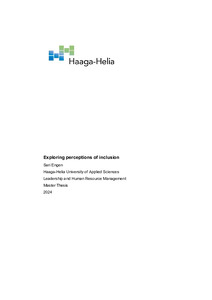Exploring perceptions of inclusion
Engen, Sari (2024)
Engen, Sari
2024
All rights reserved. This publication is copyrighted. You may download, display and print it for Your own personal use. Commercial use is prohibited.
Julkaisun pysyvä osoite on
https://urn.fi/URN:NBN:fi:amk-202404126367
https://urn.fi/URN:NBN:fi:amk-202404126367
Tiivistelmä
Companies are urged to grow the diversity within their workforce due to problems such as skilled-labor shortage and aging population, in combination with social pressure to build more just society. Diversity can add the competitive value, but it can also cause disadvantages in organizations. Studies suggests that organizations that are focusing on the diversity management efforts that promote a climate of inclusion, are able to get the benefits of diverse workforce while minimizing the disadvantages. However, studies also suggest, that the outcome of diversity management actions are based on how employees are perceiving the practices and processes, not as they are objectively designed and implemented in organizations. Hence, the effectiveness of these practices and processes should be evaluated based on how the employees perceive them.
The purpose of this study is to define what is the level of perceived inclusion in one of the units in company x, what areas of inclusion are in good level, and what areas of inclusion should be developed to improve the perceived inclusion. The theoretical framework of this study is based on a model that emphasizes both, the actions taken within organizations to prevent exclusion and those that promote inclusion. The research strategy used in this study was a case study. Empirical research was conducted in November 2023 through a survey distributed to all employees in the selected unit. The collected data includes both quantitative and qualitative information. Based on the study the level of inclusion was good, and all areas of inclusion were evaluated positively. Statistically significant differences were identified when comparing groups based on the duration of their employment in the company, the teams they belonged to, and whether participants held team lead responsibilities or not.
The findings suggest that it is important to focus on maintaining the good level in the future, and target developmental actions based on the length of employment.
The purpose of this study is to define what is the level of perceived inclusion in one of the units in company x, what areas of inclusion are in good level, and what areas of inclusion should be developed to improve the perceived inclusion. The theoretical framework of this study is based on a model that emphasizes both, the actions taken within organizations to prevent exclusion and those that promote inclusion. The research strategy used in this study was a case study. Empirical research was conducted in November 2023 through a survey distributed to all employees in the selected unit. The collected data includes both quantitative and qualitative information. Based on the study the level of inclusion was good, and all areas of inclusion were evaluated positively. Statistically significant differences were identified when comparing groups based on the duration of their employment in the company, the teams they belonged to, and whether participants held team lead responsibilities or not.
The findings suggest that it is important to focus on maintaining the good level in the future, and target developmental actions based on the length of employment.
